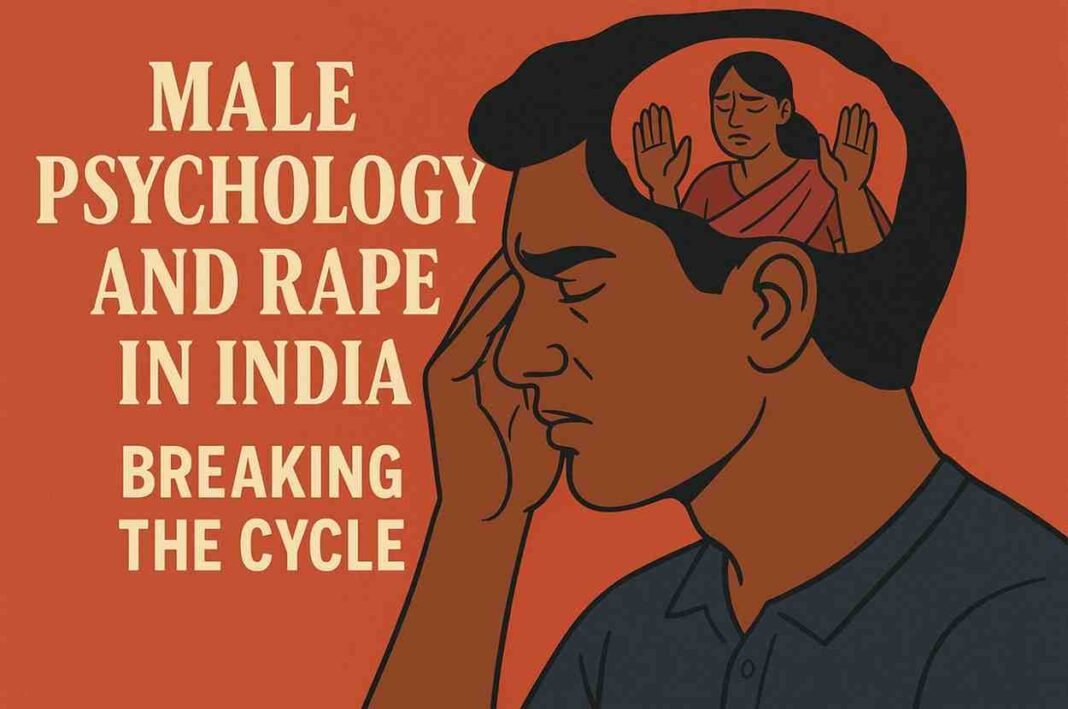India’s struggle with sexual violence remains one of its most pressing human rights challenges. While many still view rape through the lens of sexual desire, experts stress that the primary drivers are power, control, and entrenched gender inequality. This power assertion model—supported by research—frames rape as an act of dominance, not passion. The 2012 Delhi gang-rape case, where perpetrators claimed they wanted to “teach the victim a lesson” for being out late, starkly illustrates how societal attitudes fuel such crimes.
Psychological Roots of Rape: Trauma, Cognitive Distortions, and Personality Disorders
Studies of convicted rapists in India reveal disturbing patterns of emotional dysfunction and distorted beliefs. Many offenders experienced childhood trauma, abuse, or family instability, leading to insecure attachment styles and impaired empathy.
Cognitive distortions—such as believing women provoke assault or that men cannot control their urges—help offenders rationalize crimes. Traits linked to Antisocial Personality Disorder and Narcissistic Personality Disorder, including impulsivity and lack of empathy, are also common, creating a volatile psychological profile.
Male Psychology Behind Rape
Rape by men is rarely about uncontrollable sexual desire; it is largely about power, control, dominance, and entitlement. Forensic psychology identifies several recurring psychological traits among male rapists:
-
Hostility toward women — rooted in patriarchal conditioning, past rejection, or perceived slights.
-
Need for dominance — sexual violence becomes a tool to assert superiority.
-
Low empathy — inability or unwillingness to feel the emotional pain of victims.
-
Impulsivity and aggression — often linked to personality disorders such as Antisocial Personality Disorder or Narcissistic Personality Disorder.
-
Early trauma or abuse — childhood sexual/physical abuse, neglect, or dysfunctional family dynamics may impair emotional development, fueling anger and distorted intimacy.
Madonna–whore complex
In psychoanalysis, a Madonna–whore complex (also called a Madonna–mistress complex) is the inability to maintain sexual arousal within a committed and loving relationship.Freud argued that the Madonna–whore complex was caused by a split between the affectionate and the sexual currents in male desire.
Types of Rape (Based on Motivation and Circumstance)
Criminologists and victimology experts classify rape into different types:
-
Power Rape
-
Goal: To exert control and dominance over the victim.
-
Often involves verbal humiliation or threats.
-
Victim’s compliance is forced through intimidation.
-
-
Anger Rape
-
Goal: To punish, humiliate, or retaliate against perceived wrongdoing.
-
Often extremely violent and sadistic.
-
Seen in cases where offenders act impulsively after triggering events.
-
-
Sadistic Rape
-
Goal: Sexual gratification from victim’s suffering.
-
Blends sexual arousal with aggression and cruelty.
-
May involve ritualistic or fetishized violence.
-
-
Opportunistic Rape
-
Goal: Exploiting a situation with little planning.
-
Common in contexts of alcohol, drugs, or unsafe environments.
-
-
Acquaintance/Date Rape
-
Goal: Coercion or forced intercourse by someone the victim knows.
-
Offender may deny wrongdoing, claiming it was “misunderstood consent.”
-
-
Gang Rape
-
Goal: Group assertion of dominance, often linked to peer pressure and mob mentality.
-
Frequently more brutal due to group reinforcement.
-
Cognitive Causes: Distorted Thinking Patterns
Cognitive distortions are irrational, self-serving thought patterns that help offenders justify or minimize their crimes. Common distortions include:
-
Victim-Blaming
-
“She provoked me by dressing this way”
-
Shifts responsibility away from the offender.
-
-
Denial of Harm
-
“It wasn’t that bad” or “She’ll get over it”
-
Minimizes the trauma inflicted.
-
-
Misinterpretation of Consent
-
Believing silence or lack of resistance equals consent.
-
-
Hostile Attribution
-
Viewing women as adversaries, deceitful, or manipulative.
-
-
Sexual Entitlement Belief
-
Assuming men have a right to sex from women they date, marry, or know.
-
-
Normalization Through Culture
-
Absorbing rape myths from peers, pornography, or media that normalize coercion.
-
Interlink Between Psychology, Cognition, and Crime
The male psychology of rape is not just about individual pathology — it’s intertwined with cultural conditioning and social learning. For example:
-
Early exposure to violence in the home can normalize aggression.
-
Societal rape myths act as cognitive fuel for offending.
-
Peer group attitudes can reduce moral inhibition.
Societal Drivers of Rape Culture in India
India’s patriarchal social structure normalizes male dominance and subjugates women. Rape myths and victim-blaming—questioning what a survivor wore or why she was out late—remain widespread, discouraging victims from reporting crimes.
Popular media often reinforces harmful gender norms. In Bollywood films, stalking and coercive behavior are sometimes romanticized, shaping public perception and blurring lines around consent.
For marginalized women, including Dalits and Adivasis, the risk is compounded by systemic discrimination, poverty, and weak law enforcement. Institutional failures such as slow trials, insensitive policing, and outdated investigation practices further erode survivors’ trust.
Legal Reforms and Criminal Justice Solutions
While laws such as the Criminal Law Amendment Act and POCSO have expanded definitions and penalties for sexual violence, enforcement gaps persist. Speedy trials, survivor-friendly police training, and the elimination of archaic practices are essential for restoring faith in the justice system.
Education and Cultural Transformation for Prevention
Mandatory consent education in schools can change societal attitudes from a young age. Programs targeting boys and men should dismantle toxic masculinity, teach respect for boundaries, and promote gender equality.
Public awareness campaigns can challenge rape myths and shift the focus from victim behavior to perpetrator responsibility.
Psychological Interventions and Offender Rehabilitation
Early mental health intervention for at-risk youth can prevent trauma-related aggression from escalating into sexual violence. Counseling, therapy, and community-based mental health programs should address distorted beliefs and encourage empathy.
Rehabilitation programs for offenders—focused on accountability, behavioral change, and empathy building—have shown promise internationally and should be adapted for the Indian context.
Community Empowerment and NGO-Led Safety Initiatives
Grassroots efforts like self-defense training by the Red Brigade Trust empower women physically and mentally. Data-driven platforms such as Safecity help identify unsafe areas and drive infrastructure improvements like better lighting and secure public facilities.
Media Responsibility in Shaping Public Perception
Entertainment and news media must reject the romanticization of coercion and portray relationships with healthy, respectful dynamics. Responsible storytelling can play a transformative role in dismantling harmful stereotypes.
Shifting Responsibility to Perpetrators, Not Victims
Experts agree that prevention must target men, not just protect women. Early lessons on consent, rejecting slut-shaming, and holding offenders accountable are crucial. Social learning theory suggests harmful norms perpetuate across generations unless actively challenged.
The Road Ahead: Building a Safer India
Eradicating sexual violence in India requires systemic reform and cultural reengineering. This means enforcing laws rigorously, transforming education, providing mental health support, and ensuring media responsibility. Only through collective action—by government, communities, and individuals—can India shift from reacting to crimes toward preventing them.








